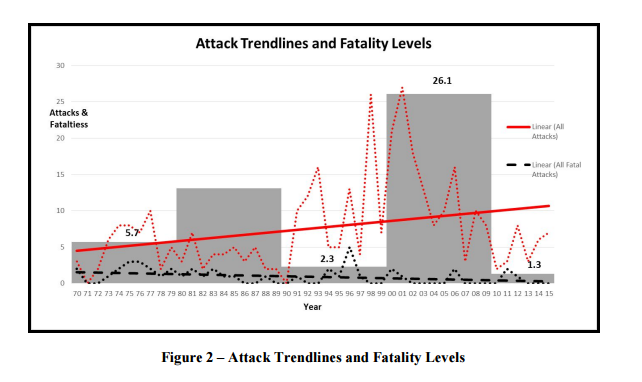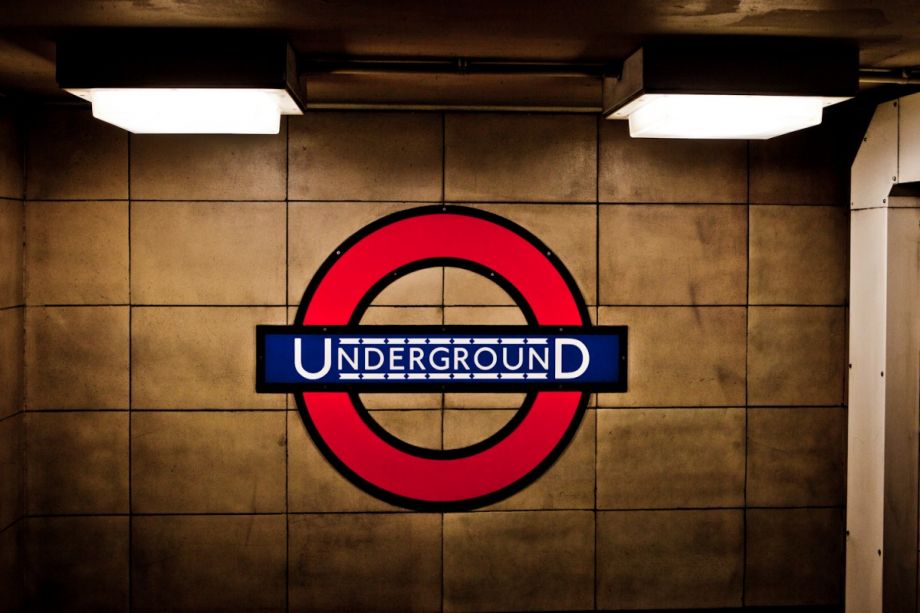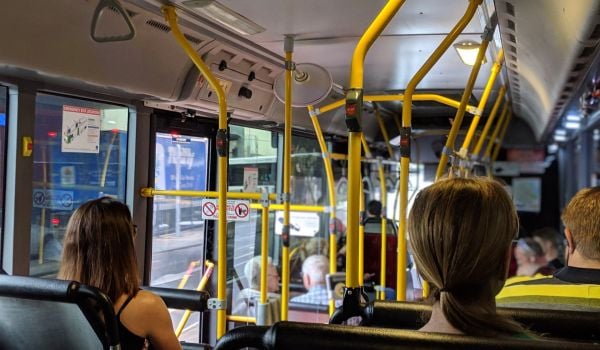Ten years after the July 2005 bombings of the London Underground, and less than six months after a thwarted attack on the Brussels-Paris train, are we safe on public transit?
“Are attacks increasing or decreasing? Are attacks becoming more or less lethal? Are security measures working?” asks a new report by the Mineta Transportation Institute at San Jose State University. It yields mixed answers: Attacks in Europe and North America are on the rise, but less lethal on average, with security measures likely thwarting more would-be attackers.
The report focuses on trends in threats to public surface transportation in Europe, the U.S. and Canada because of their similar security environments, even though collectively they account for just 387 of 4,690 total worldwide attacks since 1970. South Asia — particularly India and Pakistan — and the Middle East have experienced the greatest number of attacks: 1,274 and 810, respectively.
The report looks at attacks on trains, buses and passenger ferries, but excludes attacks on other rail infrastructure unless the perpetrators specifically intended to derail passenger trains and cause causalities.
Europe has been the victim of 371 such attacks since 1970. Since then, volume has increased while lethality has decreased — despite the especially deadly 2005 London and 2004 Madrid attacks, which caused 191 and 52 fatalities each. On average, each attack in Western Europe causes 1.4 fatalities, compared to 3.6 in South Asia.
When data on thwarted and failed attacks in Europe are included, the report suggests that while plots are on the rise, either most terrorists do not have the capability to carry out plans, or that ramped-up security measures have been successful in stopping would-be attackers. “Today’s terrorists want to run up high body counts,” states the report, “but they rarely succeed.”

While overall attacks (solid red line) have increased in Europe since 1970, the average incident fatality (dotted black line) has decreased. (Credit: Mineta Transportation Institute)
Trains and train stations have been more frequent targets than buses or bus stations, but attacks on both have increased. Of the 371 European attacks, 232 were on passenger trains and subways, 126 against buses, and three on passenger ferries or their terminals.
Enclosed environments, like underground subway stations and inside of trains, have been the sites of the deadliest incidents. Only 46 of Europe’s 361 attacks occurred in an enclosed environment, but they account for 345 of the 485 casualties and 1,958 of the 4,125 injuries. Bombings are both the most frequently employed and deadliest tactic. IEDs, car bombs, grenades or other explosives were used in 67 percent of attacks, and caused 95 percent of fatalities.
Far fewer public transportation attacks have been carried out in the U.S. and Canada, but the number of plots has risen in those countries too. Only two public transportation attacks in the U.S. and one in Canada have resulted in casualties.
Despite rhetoric from some corners of the U.S. that conflates foreigners with terrorism and overstates the threat of both, the deadliest U.S. attack was carried out not by a terrorist but by an individual with mental health issues who killed six and wounded 19 on a Long Island commuter train in 1993. The other U.S. attack, the derailment of an Amtrak train in Arizona in 1995, was claimed by a neo-Nazi group but likely the work of a single individual.
“This picture of limited fatalities and who has caused them is worth noting — they are hardly the work of conspiracies from overseas,” the report states. “‘Lone loons’ rather than ‘lone wolves’ continue to be the threat in North America.”
Nonetheless, plots are on the rise. Five plots against New York City’s subways and commuter trains were foiled between 2003 and 2009. An American-born terrorist was arrested for planning to bomb the D.C. Metro in 2010. While these attacks were stopped before they could be realized, they do point to a continued trend of targeting surface transportation.
The report concludes by asking whether security measures are making us safer. It turns out to be hard to call. There is some evidence that intensely fortified airline security has decreased the number of attempted hijackings, but the report notes that this model is hardly replicable for other forms of transit, and that deterrence measures as a whole are difficult to measure empirically. After all, “events that do not occur cannot be counted,” it notes.
Some evidence does suggest that increased television surveillance, “See Something, Say Something” campaigns and quicker authority response times did gradually reduce attacks in London between 1970 and 2000. But those same measures could not prevent the 2005 bombing, in which attackers had no fear of being seen and left no parcels to report, because they themselves were the bombs.
But that doesn’t mean ordinary citizens and transit employees are helpless. Of 300 incidents worldwide in which devices were discovered before they could detonate, transit employees discovered the devices 11 percent of the time, by passengers 17 percent of the time, by police or military 14 percent, and security officials 15 percent.
Jen Kinney is a freelance writer and documentary photographer. Her work has also appeared in Philadelphia Magazine, High Country News online, and the Anchorage Press. She is currently a student of radio production at the Salt Institute of Documentary Studies. See her work at jakinney.com.
Follow Jen .(JavaScript must be enabled to view this email address)
















